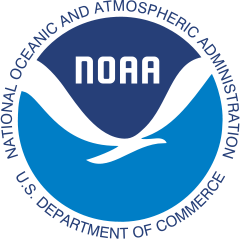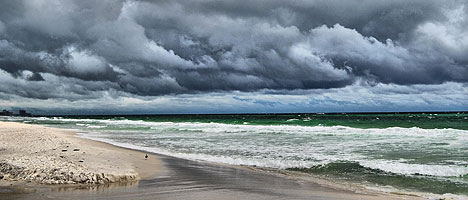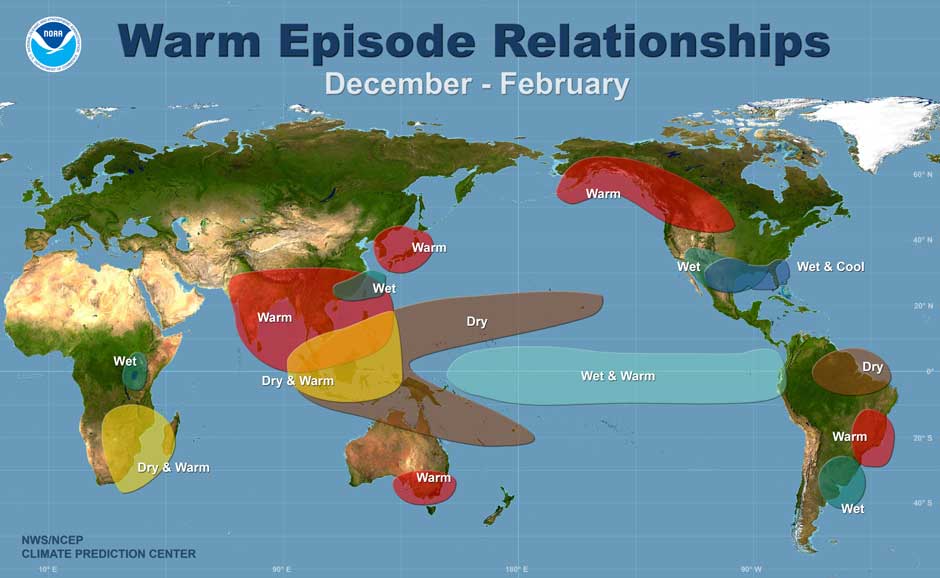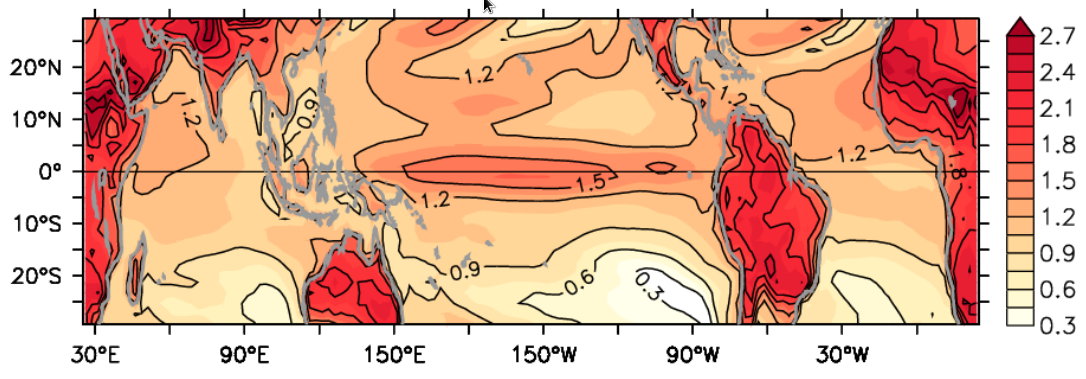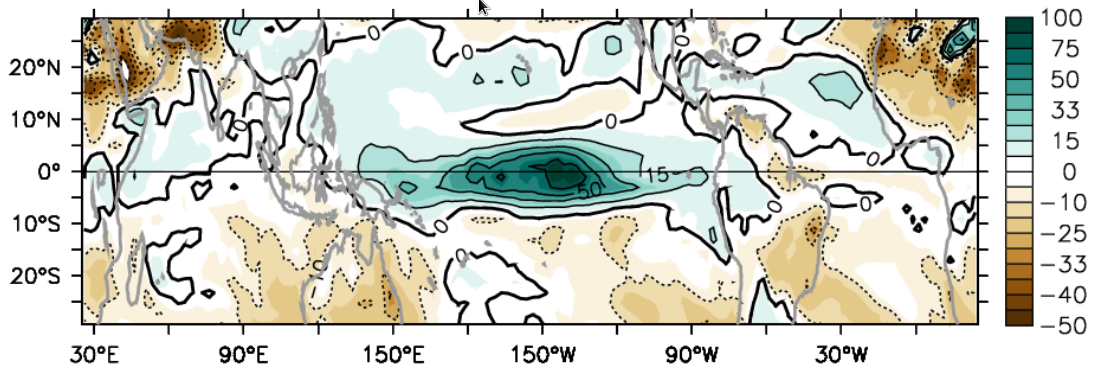El Niño and La Niña
The El Niño / Southern Oscillation (ENSO) is the Earth’s dominant mode of climate variability on seasonal to interannual time scales. ENSO is a year-to-year fluctuation of sea surface temperatures (SSTs), rainfall, winds, and currents over the tropical Pacific Ocean, which affects weather, economies, and ecosystems worldwide. GFDL pursues research to better understand and predict ENSO and other seasonal-to-interannual climate variations, including their responses to global warming. Our scientists are engaged in a vigorous effort to understand and simulate ENSO, to forecast its effects on seasonal-to-interannual time scales, and to predict how its impacts may change over the coming decades.
ENSO impacts weather worldwide. It also causes weaker upwelling and altered currents, affecting marine ecosystems and fisheries, as well as shifts in rainfall, which impact terrestrial ecosystems and agriculture.
GFDL Research
GFDL Models and Forecasts
GFDL scientists work with a hierarchy of models — ranging from simple conceptual models to high-resolution fully-coupled general circulation models — to isolate the key processes responsible for ENSO and its sensitivities to climate. Previous work focused on the role of stochastic forcings (weather) in energizing and perturbing ENSO (Vecchi et al. 2006; Gebbie et al. 2007; Zavala-Garay et al. 2010). A more recent focus has been on understanding how nonlinearities in ocean/atmosphere feedbacks generate asymmetries between warm and cold ENSO events (Choi et al. 2013; Choi et al. 2015), and using new observations and models to reassess and improve upon existing conceptual models of ENSO (Graham et al. 2014; Graham et al. 2015).
In 2005, GFDL scientists developed a new global coupled general circulation model, CM2.1 (Delworth et al. 2006). Compared to most other such models available at the time, CM2.1 produced an outstanding simulation of the tropical Pacific basin and ENSO (Wittenberg 2006; Capotondi et al. 2006; Kug et al. 2010). This model continues to shed light on the nature of ENSO, and also is used to generate seasonal forecasts — which GFDL contributes to operational efforts like the U.S. National Multi-Model Ensemble (NMME), the International Research Institute for Climate and Society (IRI), and the Asia-Pacific Economic Cooperation Climate Center (APCC). Several components of CM2.1, including the ocean and sea ice models, were ultimately transferred to the National Centers for Environmental Prediction (NCEP) and incorporated into version 2 of their operational Climate Forecast System (CFS).
Increased computer power and refinements to the simulated physical processes have enabled GFDL to produce several very promising new models — CM2.5 and CM2.6 (Delworth et al. 2012), CM2.5-FLOR (Vecchi et al. 2014), and CM2.5-HiFLOR (Murakami et al. 2015). All show significant improvements in their simulations of tropical Pacific climate and ENSO, as well as in the remote impacts (teleconnections) from ENSO to the rest of the world (Jia et al. 2015; Yang et al. 2015; Krishnamurthy et al. 2015; Krishnamurthy et al. 2016; Zhang et al. 2016). New forecast systems are being developed to take advantage of these improved simulations.
ENSO Diversity and Modulation
GFDL is working to understand how ENSO has responded to past climate variations, as a guide for how it may change in the future. Wittenberg (2009) analyzed a 4000-year CM2.1 simulation with unchanging forcings, and identified a strong intrinsic modulation of ENSO — including a multidecadal waxing and waning of its amplitude — which is broadly consistent with that seen in the available instrumental and paleo-proxy (coral, tree ring, lake sediment, etc.) records.
GFDL scientists are engaged with the international scientific community in an effort to understand and simulate the full spectrum ENSO events observed in nature (Kug et al. 2010; Guilyardi et al. 2012a; Guilyardi et al. 2012b; Capotondi and Wittenberg 2013; Lee et al. 2014). Examples of this engagement include active membership within the U.S. CLIVAR Working Group on ENSO Diversity, the International CLIVAR Research Focus on ENSO in a Changing Climate, and the design team for the Tropical Pacific Observing System for 2020 (TPOS2020), among others. Major efforts include intercomparing model simulations (Capotondi et al. 2006; Guilyardi et al. 2012) and developing new methods to diagnose and improve those simulations (Guilyardi et al. 2012; Capotondi et al. 2015; Guilyardi et al. 2016), as well as evaluating the impacts of atmosphere/ocean model formulation and physical parametrizations on the simulation of the tropical Pacific and ENSO (Kim et al. 2008; Anderson et al. 2009).
ENSO Predictability and Next-generation Forecasts
GFDL is vigorously developing its ENSO models and forecast systems, to improve both the skill of its forecasts and the assessment of their uncertainties. In addition to its high-quality models, the GFDL forecast systems benefit from initialization with realistic ocean/atmosphere states, obtained through a global observational network and an advanced coupled data assimilation method that inserts observations into the model using an ensemble adjustment Kalman filter (Zhang et al. 2004; Zhang et al. 2005; Zhang et al. 2007). Work is proceeding on methods to reduce coupled model biases that can harm forecast performance; one such method is through the use of flux adjustments, which aim to improve the model climatology through minor adjustments to the surface heat and momentum fluxes over the ocean, while still retaining full global coupling of the ocean and atmosphere. Early results indicate significant improvements in both the quality of the simulated climatology and the simulated variability; whether the flux adjustments also improve the forecasts is an area of active investigation.
A recent focus of GFDL research has been to assess the fundamental predictability of ENSO. Wittenberg et al. (2014) examined the predictability of extreme-ENSO epochs, and found that even small perturbations can disrupt them — suggesting that they may emerge by chance, and without decadal-scale predictability. Additional work by Karamperidou et al. (2014) indicates that while the predictability of CM2.1’s ENSO can vary from decade to decade, these variations are rather small. Current efforts are focusing on the predictability of different flavors of ENSO events, using advanced statistical techniques (Chen et al., in prep).
GFDL is actively engaged in multi-institutional efforts to assess how the various components of the global observing system contribute to seasonal-to-interannual forecast skill (Sun et al. 2007; Xue et al., in prep). Future work will aim to use the forecasts themselves as indicators of the sources of model climatological biases, by tracking the time-evolution of these biases to help isolate the responsible processes.
ENSO in a Changing Climate
A major focus of GFDL research has been understanding the impact of radiative forcings on tropical Pacific climate and ENSO (Wittenberg 2002; Vecchi et al. 2006; Xie et al. 2010; DiNezio et al. 2012; Knutson et al. 2013; Knutson et al. 2014). Work co-authored by GFDL scientists (DiNezio et al. 2012) showed that when driven by estimates of future greenhouse gas increases, most climate simulations over the next several decades generate competing changes in the coupled feedbacks that amplify ENSO — leading to relatively little net change in the amplitude of ENSO itself, although the underlying ENSO mechanisms do change. Recent review articles (Vecchi and Wittenberg 2010; Collins et al. 2010; Capotondi et al. 2015 Wittenberg 2015), also co-authored by GFDL scientists, summarized the state of the science on how ENSO varies intrinsically, and how it responds to climate change. GFDL has contributed heavily to community-wide assessments, including the IPCC assessment reports. For example, GFDL contributed many terabytes of simulation data, from several of its coupled GCMs, to the Fifth Coupled Model Intercomparison Project (CMIP5). GFDL scientists were also contributing authors to the Working Group I report of the IPCC Fifth Assessment (AR5), which synthesized results from worldwide research on the ENSO response to projected climate changes.
Tropical climate change: Future changes in tropical surface temperatures (°C, top) and rainfall (%, bottom), based on a 5-member ensemble-mean change over 2000-2050 from a CM2.1 simulation forced with SRES scenario A1B. The strongest warming is expected over land. The equatorial Pacific is also expected to see enhanced warming, with substantial increases in both the amount and interannual variability of rainfall. From Xie et al. (2010).
These results suggest that to understand the future of ENSO, it may be essential to understand how ENSO has behaved in the past. GFDL scientists are therefore working to improve understanding of paleo proxy records, and how they can be used to estimate the climate and variability of the equatorial Pacific over the last millennium (Emile-Geay et al. 2013a; Emile-Geay et al. 2013b; McGregor et al. 2013). A related effort is simulating the tropical Pacific response to past orbital forcings (Erb et al. 2015).
The interannual variations of ENSO are known to interact with longer-term climate changes in the tropical Pacific ocean and atmosphere. Work by GFDL researchers is helping to illuminate both how ENSO affects the climatological background state (Watanabe and Wittenberg 2012; Watanabe et al. 2012; Ogata et al. 2013; Delworth et al. 2015) and how that background state affects ENSO (Wittenberg 2002; DiNezio et al. 2012; Wittenberg 2015; Atwood et al., in prep).
